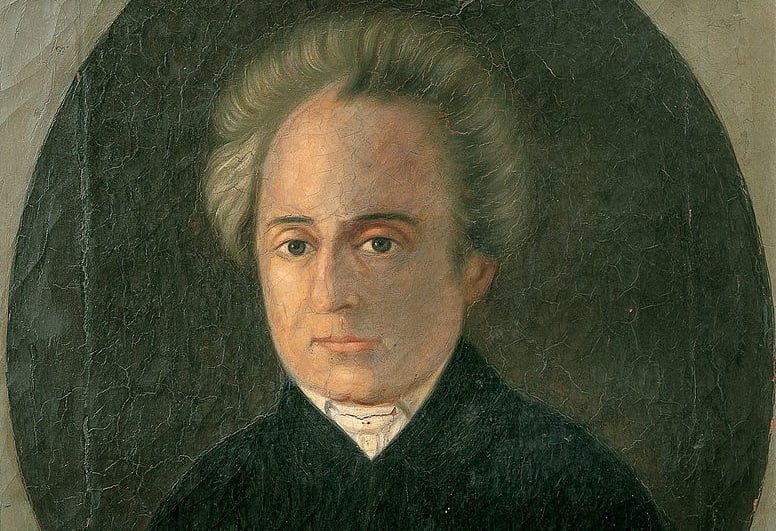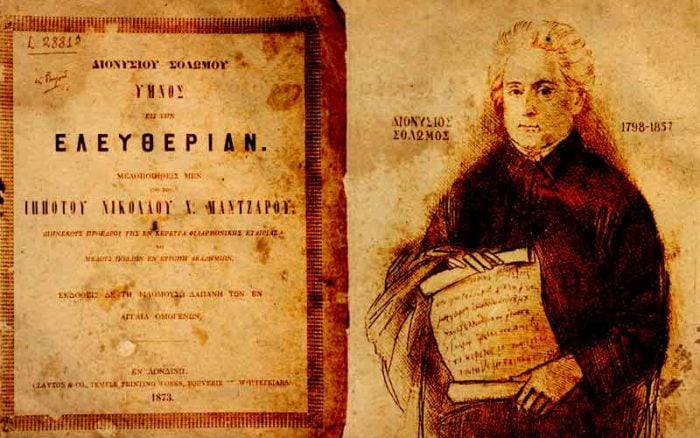
Dionysios Solomos, born on the island of Zakynthos in 1798, is rightly regarded as the National Poet of Greece for writing “Imnos eis tin Eleftherían,” (“Hymn to Liberty”), the first two stanzas of which became the national anthem of Greece.
His work had a monumental influence in uniting Greeks and creating a common national identity following the 1821 War of Independence and the establishment of a free state.
Dionysios Solomos, the creator of the Hymn to Liberty
The Hymn to Liberty, which was written in 1823, consists of 158 stanzas, and combines elements of romanticism and classicism. It is made up of tetrastic stanzas, in which octosyllabic and heptasyllabic verses alternate.
The Corfiot musician Nicolaos Mantzaros composed a melody for the words in 1828. Based on popular rhythms, it was originally written as a four-part harmony choral work. After that the anthem was regularly played on national holidays and in the houses of Corfu merchants, coming to be considered the unofficial hymn of the Heptanese.
Mantzaros modified his original melody several times – the second in 1837, the third between 1839 and 1840, and the fourth in December 1844 – before he presented it to King Otto I.
In 1865, the first three stanzas (and later the first two) officially became the national anthem of Greece; in 1966, this was also adopted as the national anthem of the Republic of Cyprus.

Solomos wrote the hymn to honor the courageous struggle of the Greeks for independence after centuries of Ottoman rule.
The poem recounts the misery of the Greeks under the Ottomans and their desperate hope for freedom. He describes several events of the War, including the execution of Patriarch Gregory V of Constantinople, the reaction of the Great Powers, the Siege of Tripolitsa and the Christian character of the struggle.
The Greek National Anthem
Σε γνωρίζω από την κόψη
Του σπαθιού την τρομερή,
Σε γνωρίζω από την όψη
Που με βιά μετράει τη γη.
Απ’ τα κόκκαλα βγαλμένη
Των Ελλήνων τα ιερά
Και σαν πρώτα ανδρειωμένη
Χαίρε, ω χαίρε Ελευθεριά!
Και σαν πρώτα ανδρειωμένη
Χαίρε, ω χαίρε Ελευθεριά!
Και σαν πρώτα ανδρειωμένη
Χαίρε, ω χαίρε Ελευθεριά!
English translation:
I know you by the dreadful
edge of the sword,
I know you by the gaze
that measures the land with force.
Born from the sacred
bones of the Greeks
and brave as in the old times
Hail, oh hail, Liberty!
And brave as in the old times
Hail, oh hail, Liberty!
And brave as in the old times
Hail, oh hail, Liberty!
The Greek poet of liberty
Solomos, who was the central figure of the Heptanese School of poetry, is considered to be the national poet of Greece — not only because he wrote the national anthem, but also because he contributed to the preservation of an earlier poetic tradition and highlighted its usefulness to modern literature.
After completing The Hymn to Liberty, Solomos continued to write impressive poetry, but never fully completed another work, and very few of his works were published in his lifetime. He had moved to Corfu and also established a literary circle there.
Solomos suffered a series of strokes toward the end of his life and passed away on February 9, 1857. His remains were returned to his native island of Zakynthos in 1865.
See all the latest news from Greece and the world at Greekreporter.com. Contact our newsroom to report an update or send your story, photos and videos. Follow GR on Google News and subscribe here to our daily email!



